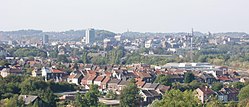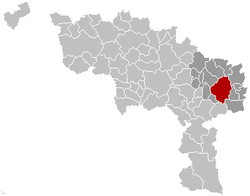Charleroi
| Charleroi | |||
|---|---|---|---|
| Municipality | |||

Skyline of Charleroi
|
|||
|
|||
| Location in Belgium | |||
|
Location of Charleroi in the province of Hainaut
|
|||
| Coordinates: 50°24′N 04°26′E / 50.400°N 4.433°ECoordinates: 50°24′N 04°26′E / 50.400°N 4.433°E | |||
| Country | Belgium | ||
| Community | French Community | ||
| Region | Wallonia | ||
| Province | Hainaut | ||
| Arrondissement | Charleroi | ||
| Government | |||
| • Mayor | Paul Magnette (PS) | ||
| • Governing party/ies | PS, CDH, MR | ||
| Area | |||
| • Total | 102.08 km2 (39.41 sq mi) | ||
| Population (1 January 2016) | |||
| • Total | 202,182 | ||
| • Density | 2,000/km2 (5,100/sq mi) | ||
| Postal codes | 6000, 6001, 6010, 6020, 6030–6032, 6040–6044, 6060, 6061 |
||
| Area codes | 071 | ||
| Website | www.charleroi.be | ||
Charleroi (French pronunciation: [ʃaʁləʁwa], Walloon: Tchålerwè) is a city and a municipality of Wallonia, located in the province of Hainaut, Belgium. By January 1, 2008, the total population of Charleroi was 201,593. The metropolitan area, including the outer commuter zone, covers an area of 1,462 square kilometres (564 sq mi) with a total population of 522,522 by January 1, 2008, ranking it as the 5th most populous in Belgium after Brussels, Antwerp, Liège, and Ghent. The inhabitants are called Carolorégiens or simply Carolos.
The municipality of Charleroi straddles both banks of the river Sambre in an area marked by industrial activities (coal mining and steel industry), which has been nicknamed the Pays Noir ("Black Country"), part of the larger sillon industriel. Even though most of the factories have closed since the 1950s, the landscape remains dotted with spoil tips and old industrial buildings.
Charleroi lies around 50 kilometres (31 mi) south of Brussels.
The municipality comprises:
and the following former municipalities, merged into Charleroi in 1977:
Neighboring municipalities:
The Charleroi area was already settled in the prehistoric period, with traces of metallurgical and commercial activities along the Sambre. Several public buildings, temples and villas were built in the area in the Roman period. Burial places, with jewels and weapons, have been found. The first written mention of a place called Charnoy dates from a 9th-century offering in the Lobbes abbey, which lists various neighboring towns and related tithe duties. During the Middle Ages, Charnoy was one of the many small hamlets in the area, with no more than about 50 inhabitants, part of the County of Namur.
...
Wikipedia




